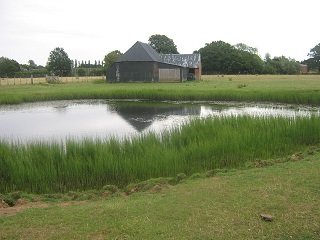 I believe it’s a fair guess that, wherever you live, there are a handful of decent lakes, rivers, or farm ponds teeming with fish waiting to be caught. While you may be surprised at the number of fishable waters in your neck of the woods, even in urban areas, I’ll bet you’d be even more surprised at the size of the fish you can catch there. Today we’ll look closer at how you can score big bass in small waters.
I believe it’s a fair guess that, wherever you live, there are a handful of decent lakes, rivers, or farm ponds teeming with fish waiting to be caught. While you may be surprised at the number of fishable waters in your neck of the woods, even in urban areas, I’ll bet you’d be even more surprised at the size of the fish you can catch there. Today we’ll look closer at how you can score big bass in small waters.
It’s a common belief that waters where you can’t put in a boat aren’t as pressured as more popular lakes. It’s true that the average farm pond doesn't see any wakes, but a single angler can still cause the bass in a small body of water to become wary to pressure quickly. Chances are that the biggest bass in a given pond have been hooked at some point in their lives. For this reason, you’ll need to make sure your presentation is as realistic as possible. If a lure doesn't look real, they aren't biting it.
Soft plastics are some of go-to’s for ponds, and it’s hard to beat flukes. Texas-rigged or fastened to a wide-gap hook, flukes can be deadly in these situations. You’ll want to sight-cast these beauties to shallow cover like stumps with a twitch and fall retrieve, especially in spring. They can also be “walked” across the surface or just under it with great effect, as well.
There are times when the fish in a small pond are wary of even the most life-like lures, but they will rarely pass up a live bluegill. A good five-inch bluegill may not get hit often, but when it does, hang on tight. To rig a live gill, hook it under the dorsal fin, about an inch forward from the tail, and clip a large bobber to the line a few feet above the hook. Cast the gill to prime bass spots such as laydowns, weedbed edges, or stump thickets and then wait for the fun part.
Can’t decide if your local small pond is a good spot to seek big fish? Here are a few things to look for: a slight stain, cover, and deep, shady banks. Slightly stained water means better fertility, which means more food for baitfish, which means more food for big fish. Stained water also helps hide heavier braided lines, which you’ll want to use, considering the amount of weeds, pads, or timber you’ll be dealing with. Baitfish need cover to hide from predators, but big largemouths also spend most of their days seeking the cool shade of cover. Therefore, the more laydowns and weedbeds there are in a given pond, the more places you’ll potentially find big bass. If such cover is sparse, this is where deep, shady areas are important, as they provide a retreat from the sun’s heat.
I’ve personally pulled huge bass from ponds no bigger than a basketball court, so believe me when I say it can be done. Pulling up an online map of your area and looking for small lakes, rivers, and ponds can yield a treasure trove of big fish just waiting to be caught. The tips outlined above will further help you in this quest.








